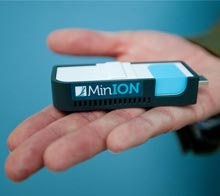Even small clinical pathology laboratories could afford this new miniaturized gene sequencer
Is the profession of pathology and clinical laboratory medicine ready to deal with point-of-care DNA sequencing technologies? A company in the United Kingdom says that, as early as next year, it can bring a portable high-throughput unit to market that will sell for around US $900.
Researchers at Oxford Nanopore Technologies Ltd. (ON) have developed new-generation sequencing technology that uses nanopores to deliver ultra-long, read-length, single molecule sequence data, the company stated in a press release. And it does this with competitive accuracy on a high-throughput electronic platform.
The miniaturized sensing instrument is called MinION. It is about the size of a USB memory stick and works with a normal laptop computer. If the company’s claims bear out, it could make nanopore sequencing universally accessible.
“[It is] a truly disruptive single molecule analysis technique, designed alongside new electronics to be a universal sequencing system,” stated Gordon Sanghera, Oxford Nanopore’s Chief Executive Officer.
Portable DNA Sensor Hits 100,000-Base Continuous Sequencing Milestone
The MinION is a single-use, miniaturized, single molecule sensing version of ON’s GridION platform. It is made possible by the company’s recent advances in its proprietary arrayed sensing chip. The MinION device plugs directly into a laptop or desktop computer through a USB port. It eliminates the need for DNA amplification and expensive reagents and is compatible with complex samples, such as blood or serum that are commonly collected and testing by medical laboratories.

Developed by Oxford Nanopore, the MinION is a DNA sequencing system that can fit in the palm of your hand. It plugs into into a personal computer like a USB memory stick. The single-use sequencer will be on the market for under $900 sometime in the next year. (Photo copyright by Oxford Nanopore.)
The device works by passing a single strand of DNA through a protein pore created in a membrane, Technology Review explained in a story titled, “Why a Portable DNA Device Could Yield Better Data”. An electric current flows through the pore. Different DNA bases disrupt the current in different ways, allowing the machine to electronically read out the sequence.
According to Zoe McDougall, Director of Communications at ON, one of the biggest advantages of the company’s nanopore device is the read length. She pointed out that the ability to read longer segments of a genome directly makes it easier for researchers to see large-scale patterns that may be markers for cancer and other diseases. Cutting DNA into shorter segments for sequencing and then reassembling the stretches on a computer increases the risk of missing or misinterpreting structural variants.
McDougall explained that current sequencers typically can read DNA fragments a few hundred base pairs in length. “We’re showing a genome of around 5,000 base pairs and we’ve sequenced it as a hairpin—we’ve sequenced both strands in one go,” she stated in a story on the website of the Royal Society of Chemistry RSC. That gives a read length of about 10,000 bases.
According to Technology Review, ON reported at a research conference earlier this year that it had continuously sequenced roughly 100,000-base stretches of DNA in the lab.
A Step toward More Effective Individualized Medicine
Within its 6-hour life, the disposable MinION can read over 150 million bases, Gizmag.com reported. That’s 75 million base pairs. For comparison, the largest human chromosome, chromosome 1, contains approximately 250 million base pairs, or 500 million bases. The human genome contains just over 3 billion base pairs, or 6 billion bases.
According to a January 2012 story, in the Wall Street Journal, the cheapest sequencing of a whole human genomecurrently available is $3,000. It takes about a week to generate. A recent press release announced that one of the rivals in the sequencer race is “on pace to deliver the $1,000 genome by year’s end.”
Clinical laboratory managers and pathologists will note that ON’s new device is more evidence of the rapidly accelerating pace of sequencing technology. One goal of researchers is to make it possible to shift more clinical laboratory testing currently performed inside traditional core laboratorys and nove this testing to near-patient settings.
—Pamela Scherer McLeod
Related Information:
Why a Portable DNA Device Could Yield Better Data
Sequencing Developers’ Unprecedented Success Drives More Ambitious Goals For Genomics X Prize




it is good but still we need amplification the DNA before sequening .